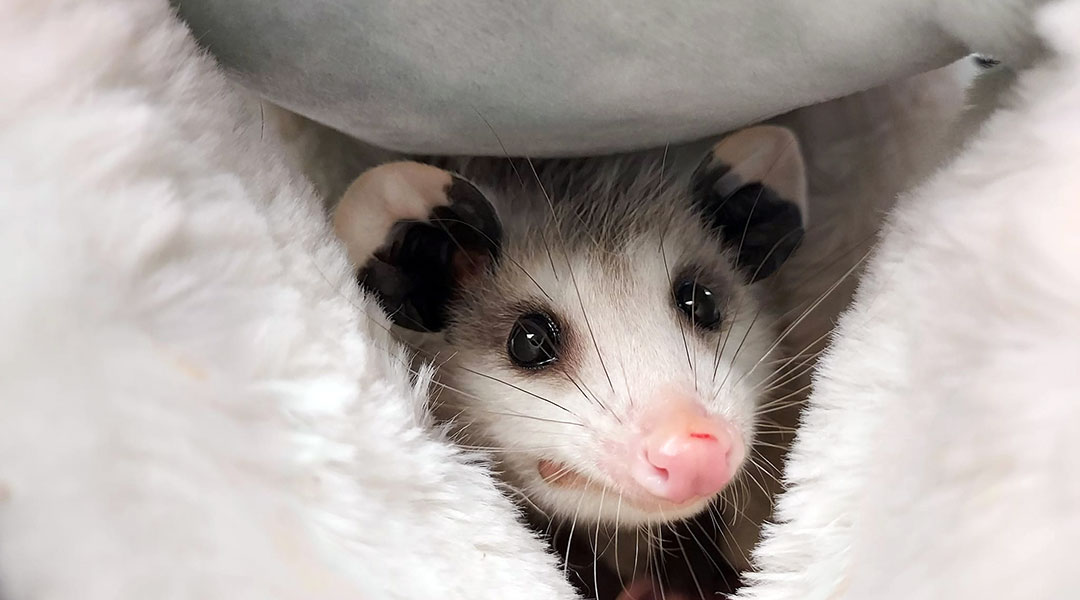An opossum at the Carolina Wildlife Center. The wildlife rehab facility was forced to stop taking baby possums due to overcrowding but is planning on accepting them again in 2023. (Photo courtesy of the Carolina Wildlife Center)
The Carolina Wildlife Center took in 20% more animals during the first two years of the pandemic and struggled with overcrowding.
That’s 1,000 more animals in a year than usual, said volunteer and board member Arnie Wodtke.
Why the jump? The increased time that people spent in their backyards or outside meant they found more animals in need.
The sharp increase in animals turned over to the rehabilitation center coincided with a labor shortage that left the organization understaffed and overworked. As a result, the center was forced to stop taking baby opossums.
“We are the only permitted songbird rehab center in the Midlands, so we keep that as our primary function,” Wodtke said. “We have backup on mammal care, we do not have backup on birds, and we do not have backup really for reptiles.”
The pandemic isn’t the only cause for an uptick in wildlife taken in by the center. As Columbia continues to grow, the number of displaced animals does, too.
Problems arise “anytime you have a major housing development or major construction area where they’re ripping up trees,” Wodtke said.
The good news is that the center on Bush River Road plans on returning to business as usual this year. Overcrowding is still a concern for Wodtke and the rest of the board, though.
“We’re only a 2,000 square-foot building,” Wodtke said. “We can only offer so much proper care, and we will not offer improper care.”
Leilani Münter, a former race car driver and Columbia-area resident, volunteers for the center as well. She’s been an environmental activist for years, advertising conservation documentaries The Cove and Blackfish on her car during her racing career. Münter now spends her time volunteering at various wildlife organizations. She’s seen the same issues the Carolina Wildlife Center deals with across the country.
“This has been the case with every nonprofit wildlife rehab I’ve worked with,” Münter said. “They’re all short funded. They’re all short on space. They’re short on people. They’re short on money.”
So what can the average South Carolinian do to help?
Jay Keck, a habitat manager for the South Carolina Wildlife Federation, said education is the most important thing his organization provides.
“If you don’t know about it, how are you going to care for it?” he said.
The federation offers a 12-week course where Midlands residents can earn a South Carolina Master Naturalist certification, Keck said. It also hosts trivia nights and other events to raise awareness.
We’re “just getting people aware that there’s this amazing planet out there,” Keck said. “Then, they’ll be more apt to actually do something on their property for all these amazing creatures that they might not even know exist in their backyard.”
Another simple action environmentally conscious individuals can take is planting gardens with native vegetation. Local plants support the insect population, he said.
“You’re going to be supporting everything else if you support insects,” Keck said.
Münter doesn’t think there’s enough public awareness of the benefits of native plants.
“I don’t think the people who are planting these non-native things in their yard are thinking, ‘Oh, I don’t care about wildlife,’” Münter said. “They’re just thinking, ‘I want to make my backyard look pretty.’”
Münter also mentioned rewilding, a type of conservation that emphasizes returning an area to its natural uncultivated state. Planting native plants is often the first step.
University of South Carolina Professor of Biological Sciences Carol Boggs had some specific advice for those looking to help conservation efforts in their own backyard.
“Convert expanses of turf grass to either native wildflower, shrubs, trees,” Boggs said in an email. “Or at least an intermix of clover to reduce fertilizer use; reduce fertilizer, herbicide and pesticide use.”



